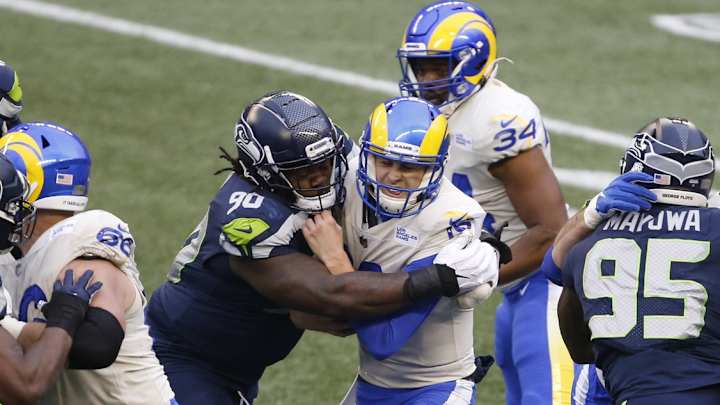The Pros and Cons of One-Year Contracts

The Kansas City Chiefs have handed out oodles of one-year contracts in the 2021 offseason.
Austin Blythe, Jarran Reed, Kyle Long, Mike Remmers, Daniel Sorensen, Demarcus Robinson and many others have received one-year contracts from the Chiefs. The only multi-year contract the Chiefs have given out went to guard Joe Thuney.
In an offseason with a falling salary cap, it was not surprising to see many players around the league take one-year contracts in order to try and cash out next season. One-year contracts for players like JuJu Smith-Schuster and Anthony Harris were abundant.
One-year contracts are mostly viewed as positives for teams with "low-risk, high-reward" being the general description of such contracts.
However, one-year contracts have more negatives than meet the eye.
There is one fundamental truth about one-year contracts that need to be understood: they do count against the salary cap over the course of multiple years. How? Rollover salary cap space.
NFL teams are able to roll over any salary cap space that was not used in the previous season. For example, the Chiefs finished the 2020 season with roughly $5 million in salary cap space. Due to this extra cap space, the Chiefs’ base salary cap for the 2021 season was not the $182.5 million salary cap number reported by the NFL a few weeks ago but about $187.6 million.
Rolling over unused salary cap space is how teams like the Jaguars and Colts can end up with so much cap space in a given year. Pairing a large amount of rollover salary cap with an already-cheap roster leads to some crazy salary cap space numbers.
One-year contracts eat into this rollover salary cap.
The ratio that a player affects the salary cap to the amount of time they play on the roster is the worst it can be on one-year contracts. The ratio of the one-year play for a team to two years affecting the salary cap pales in comparison to multi-year contracts. For one-year contracts for substantial money, say greater than $5 million, this trade-off needs to be kept in mind.
Speaking of those larger one-year contracts, another major problem with one-year deals arises when examining those substantial one-year agreements. This is because it is harder to manipulate money with one-year contracts.
Take new Chiefs defensive tackle Jarran Reed as an example. Unless the Chiefs want to use void years, they are stuck with the $5 million salary cap hit for Reed in 2021. This is because there are no extra years to spread out a signing bonus. The spreading of the signing bonus, otherwise known as the prorated bonus, is the main system NFL teams use to control salary cap hits. One of the only remaining ways to spread out the salary cap charge is offering NLTBE (not likely to be earned) incentives. NLTBE incentives are only charged against the team’s salary cap in the following year if the player earns them.
Currently, it is unknown what Reed's incentives are, but as an example, if the incentives are classified as NLTBE incentives, then if he earned the incentives during the 2021 season it would charge $2 million against the Chiefs’ 2022 salary cap.
How does the lack of flexibility with one-year contracts present itself? Consider this: Joe Thuney on his five-year/$80 million contract is counting $500k less against the Chiefs’ 2021 salary cap than Jarran Reed.
Even considering the negatives surrounding one-year contracts, the benefits should not be ignored.
The clear and obvious advantage one-year contracts provide is the lack of long-term investment. If Jarran Reed is a disappointment for the Chiefs in 2021, there are no additional dead cap charges for letting him walk next year. If he signed a two-year contract with any signing bonus, then there would likely be dead cap charges if the Chiefs cut him. A signing like Alex Okafor showed some of the pitfalls of even a modestly sized contract and how most contracts are not flexible until after year two, generally.
Along with financial flexibility, draft flexibility could be acquired through these one-year contracts as well. If Jarran Reed is amazing for the Chiefs next year and earns a nice contract elsewhere after the season, the Chiefs could turn a player that did not count against the compensatory pick formula (due to Reed being cut) into a compensatory pick. While carrying the contract took up a fair amount of salary cap room, acquiring a mid-round pick along with a great 2021 season out of the one-year contract is easily worth the investment. These are the type of value bets that one-year contracts provide.
Looking at the specific one-year contracts the Chiefs handed out in the 2021 offseason, they seem to fall on the good side of one-year deals. The single one-year contract that is of a substantial amount so far (Jarran Reed) was a player who was cut. Not counting against the compensatory pick formula is huge for the Chiefs, who should be looking to gain as many compensatory picks as possible while Patrick Mahomes is their quarterback. Austin Blythe, Kyle Long, and the Chiefs’ re-signings are all relatively small-money contracts, so while they do lower the rollover cap space, the benefits outweigh the costs.
Like any contract in the NFL, one-year deals are all about striking the cost/benefit balance. They are not universally great contracts, but they offer a different value proposition than most other contracts handed out. Finding that balance lets teams strike gold more often than not.
Read More: Potential Patrick Mahomes Adidas Logo Receives Mixed Reactions

Conner Christopherson is an alumnus of the University of Missouri, class of 2018, majoring in Computer Science. Conner is a moderator of the official Kansas City Chiefs subreddit on Reddit and writes for Arrowhead Report on SI.com. Conner is also a frequent contributor to the Roughing the Kicker Chiefs Podcast. Follow Conner on Twitter at @Conner_DKC.